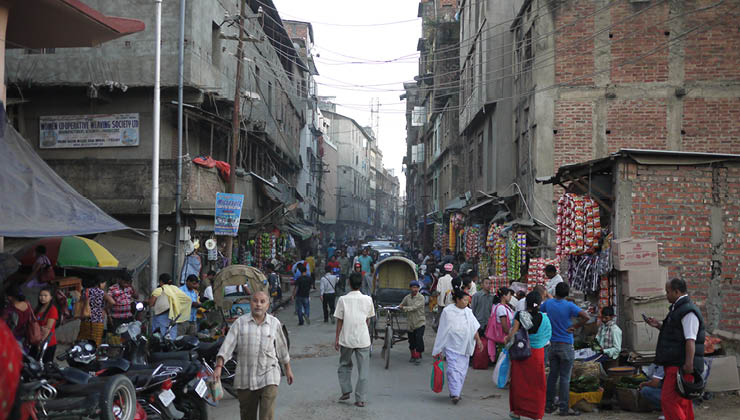What can we learn from interdisciplinary discussions that bring new perspectives to international law and feminist legal theory? In this blog Sheri Labenski and Caterina Polidoro discuss architectural methods and practice and its potential implications for peace, gender and the law.
Cross-disciplinary conversations are an important part of feminist practice but often, actually taking part in such an exercise can seem daunting. How can I make a meaningful contribution when conversing with someone from a field I know little about? Due to this, feminist international legal scholars tend to have cross-disciplinary chats with people from fields that are ‘law adjacent’. The field of architecture, for instance, is a relatively under-explored area within international legal scholarship and does not tend to feature high on the list of relatable fields to international law. However, the material that links architecture and peace is ever-growing.
So in an effort to understand a bit more about architectural methodology, practice and its potential implications for peace, gender and the law, I sought out the expertise of Caterina Polidoro (Katia). Katia is an architect and a director at TP Bennett, where she primarily focuses on major retail and mixed use developments. Her experience in urban design and architecture has also enabled her participation in Article 25 (Development & Disaster Relief) and Architecture Sans Frontières, UK. After many enjoyable and illuminating conversations over the past year and a half, Katia and I began to see how many of the challenges within our respective fields are strikingly similar. The following is a reflection on some of the key points that emerged from our discussions. This blog attempts to think through these points of intersection, and how they encourage new pathways for further exploration within both of our fields.
When Katia and I first met we discussed what we ‘do’- what is the essence of what we are trying to accomplish in our respective fields?
For Katia:
“The architect’s role should be the one of facilitator and moderator, mediating between different stakeholders and their diverse often opposing issues and demands. They should not be the fountainhead from which the ‘design truth is spoke’ but the facilitator who helps to shape the future built environment in collaboration with end users.”
Katia’s comments have implications for international law as well. Many feminist legal scholars have likewise cautioned international lawyers against making dangerous assumptions in the post-conflict climate, about what is ‘best’ for a community or individuals. Otto’s work on the ‘politics of listening’ came to mind. Otto, referring to armed conflict and the ways in which the international community deals with the aftermath, states, “we need to recognise our collective responsibilities by acknowledging the benefits of the present system”. Katia urged architects involved in any type of community focused design to question their own assumptions about what people need and want, and to actively listen to the problems and challenges a community faces before starting the design process. She stated that architects must be afforded the ‘luxury of listening’ in order to reflect on their own culpability.
This led Katia and me to a discussion of how international law, like architecture, must constantly evolve. She stated:
“Architecture facilitates harmonious coexistence and interaction of communities, with spaces and places designed for all, not just the physically accessible spaces, but also places able to challenge physical and cultural separation and segregation. The architect should have the ability to understand and cater for change in society, respect and respond to different identities, but must avoid the risk of crystallising them.”
What struck me was Katia’s concern that architecture can entrench biases by reproducing narrow ideas of space. I must admit the concept did not previously occur to me. I am familiar how international legal mechanisms like the Women, Peace and Security agenda, for instance, have been critiqued for assuming women are perpetual victims in armed conflict, without the recognition that women’s experiences fall into many different places along the spectrum of peace and conflict. Yet, the thought that physical space could solidify identities had not resonated until this point. I suppose I wrongly assumed that it was the people inhabiting the building that shaped how it was used. Now, I cannot help but think of the construction of a physical space and its ability to push individuals further away from peace.
Katia and I then moved to a discussion of refugee camps and their design. Despite the fact that they should be a temporary living space, they tend to exist far longer than they should, with some camps lasting for decades. Yet, because they are not designed to exist in the long term, they are not created to function like a community and it is those inhabiting these spaces who are left to rearrange and make their space liveable.
Some might be resistant to making camps more liveable as it might let states ‘off the hook’ and slow down the drive to return, relocate or resettle individuals. But where does this leave those who live in camps in the meantime? Agier discusses the link between the creation of new forms of democracy and community within refugee camps, which positions camps as a key site for both political and legal change. Petti sees the camp as a way to rethink the role of the nation state.
At the very least, it seems that when we invoke the Women, Peace and Security agenda to demand that women be involved in every aspect of peace and peacebuilding, we need to reiterate that this is the case for everything- from the negotiating table to those who construct the table.
Clearly there are links between architecture and law/legal theory, but on a practical level, where does gender sit within this debate? Katia spoke to me about the worry that spaces are designed with ‘industry standards’ or assumptions of proportion and usage that are inherently tied to ‘men’, i.e. gendered. She stated, “[a]rchitects often come with pre-made solutions based on established preconceptions.”
Farrington expresses a similar worry, and urges the creation of refugee camps with female architects as well as women and girls in order to create safe and usable spaces. My ignorance of this area of study, and the links between feminism, architecture and refugee camps reminded me of the concerns that brought me to Katia in the first place. How can international law learn from these conversations on architecture? At the very least, it seems that when we invoke the Women, Peace and Security agenda to demand that women be involved in every aspect of peace and peacebuilding, we need to reiterate that this is the case for everything- from the negotiating table to those who construct the table.
Considering the many conversations Katia and I had, we were both motivated to continue to explore interdisciplinary perspectives. She urged:
“It is our duty to overcome the risk of being auto-referential, by looking into other discipline’s methodologies, strategies, and knowledge. This is the duty of interdisciplinarity that forces you to look at a common topic from a completely different perspective, this is the advantage of coming out of our comfort zone and re-looking at our own assumptions.”
Through my discussions with Katia I realised that architecture, beyond creating beautiful buildings, can, in a post-conflict situation, help to understand the needs and issues of a community and promote reconciliation, and that spaces by their very design and assumptions within can reproduce harmful gender ideals. Our chats were undoubtedly enjoyable and yet allowed us both the time to think of our professions and our presumptions from a new perspective. Detailing the debates, concerns and challenges to someone less familiar with our respective fields, made us both realise how close our areas were linked and that we too must resist the tendency to silo our professions.
Through my discussions with Katia I realised that architecture, beyond creating beautiful buildings, can, in a post-conflict situation, help to understand the needs and issues of a community and promote reconciliation, and that spaces by their very design and assumptions within can reproduce harmful gender ideals.
While Katia and my discussions also covered the role of feminism in architecture, the links between gender and architectural theory and the role architects have in political debates (with transgender rights of accessibility to public spaces being an important topic), I am unable to do them justice here. This blog merely highlights some of the key themes Katia and I have discussed over our time together, namely: listening, adaptation and interdisciplinarity, each of which sit within architecture and feminist legal theory. They amplify the importance of feminist practice within law and architecture and the lessons to be learned through engaging in a cross-disciplinary conversation.
At the end of this reflection, I have more questions than answers, but I am encouraged by the outcome of our conversations. Moreover, I am certain that discussions which interlink architecture and peace have great potential to illuminate new perspectives on the challenges found within international law and feminist legal theory.
This blog was written with the support of a European Research Council (ERC) grant under the European Union’s Horizon 2020 research and innovation programme (Grant agreement No. 786494).
The views, thoughts and opinions expressed in this blog post are those of the author(s) only, and do not necessarily reflect LSE’s or those of the LSE Centre for Women, Peace and Security.





